A Guide to Kabusecha (Shade-Grown Sencha)
Know your Sencha
Shade grown Japanese sencha is extraordinary. It’s the green tea of connoisseurs. If you love good food and fine drinks and have yet to try it, you will thoroughly enjoy it. Below is my brief guide to knowing your sencha so you can buy, drink and talk about it with confidence.
True sencha is a style of green tea that comes from Japan. Tea was first documented and consumed in Japan around 800AD; however, it was around 1200AD that tea was first cultivated on Japanese soil. Since then, the Japanese have become experts at producing very fine green teas.
Season
Many people are yet to realise that tea is very seasonal. When you buy sencha, always buy from the spring season (Ichibancha). This is the first picking season of the year, when we get the most desirable flavour profile. After Ichibancha, the following seasons of Nibancha and Sanbancha produce lower quality teas with more bitterness and dry notes.

Shade-Growing
During Ichibancha, some tea plants will be grown under the shade. Partial shading of a tea plant causes a change in the leaf’s nutrients. (These nutrients are what we taste when we drink a tea.) There is an increase in the levels of amino acids which gives the tea a less bitter taste and a more savoury and umami flavour. This umami is the cornerstone flavour we look for in premium Japanese teas. A partially-shaded sencha is technically called ‘kabusecha’. It’s a term which is less commonly known outside Japan, so we often interchange the terms ‘kabusecha’ and ‘shade-grown sencha’.
Steaming
After the leaves are picked, they are heated. This heating stops an enzyme in the leaf that allows it to oxidise and change colour from green to black. Thus, the tea leaf becomes a green tea rather than a black tea. In the case of a Japanese green, this is done by steaming. When a leaf is steamed, the flavour profile moves towards the vegetal end of the spectrum.

Leaves
Examining the leaf tells you a lot about the tea. Sencha leaves should be a dark rich green and needle-like in shape. Think of little fir tree leaves. That’s what they should resemble. There’s a lot of lower quality, flat, light green leaf on the market but it’s the dark green leaf which you should look for.
Okumidori Shaded Sencha, Spring 2014, Nakai Gardens (Kyoto)

So here’s the batch we’ve chosen for the collection. This is an extraordinary 102kg single-batch, grown on the Nakai family gardens in Kyoto, Japan. The family have been farming tea for 7 generations and were one of the pioneers of organic tea in Japan.
This batch is particularly interesting because it’s from a single-varietal of tea plant (Okumidori). This varietal is smoother in texture to other varietals, and gives a very intense umami when infused at cooler temperatures.
Infuse this tea for 2 mins at 40°C. That’s just above body temperature. When you drink it, you taste the journey it’s been on. The freshness of the spring picking, the incredible umami from the shade growing, the vegetals from the steaming and the smoothness of the varietal. There are notes of green peas, kale, and kombu. The umami is intense and the finish is wonderfully long.
If you like savoury and distinctive flavours, you will adore this tea. It gets the most ‘wows’ at our tastings. You can find the Okumidori Kabusecha by clicking here.
JL





